Generative AI (GenAI) is enabling bad actors to become increasingly sophisticated in digital advertising.
A new analysis by the DV Fraud Lab has uncovered a network of over 200 properties that include mostly AI-generated, ad-supported “AI slop” sites. These sites often mimic legitimate publishers, posing threats to ad spend and campaign performance.
Dubbed Synthetic Echo by DV, the network highlights the growing challenges of the GenAI era and the urgent need for advanced tools to combat fraud and low-quality inventory.

The Network: AI-Generated and Deceptive
Monetized through a variety of sell-side platforms (SSP) and exchanges, the sites within Synthetic Echo show minimal human oversight, according to DV’s data signals.
Moreover, it includes deceptive URLs like espn24.co.uk, nbcsportz.com, nbcsport.co.uk, cbsnewz.com, cbsnews2.com, bbcsportss.co.uk, 247bbcnews.com, foxnigeria.com.ng and more — designed to mislead ad tech vendors and buyers by mimicking reputable publishers. While the domains may initially seem credible, their focus is on churning out low-quality, AI-generated content to drive ad revenue.
Leading brands, both B2B and B2C, were found running ads on these sites, likely unaware of the questionable inventory.
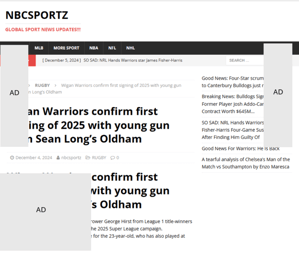
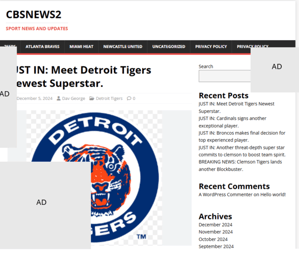
Reliant on Plagiarism, Sports and Clutter
Last year, DV surveyed 1,000 advertising leaders globally and found that over half (54 percent) believe GenAI significantly harms media quality. The GenAI slop sites in Synthetic Echo further erode trust in programmatic media buying, diverting ad budgets from quality publishers to low-quality or fraudulent inventory. In addition to this direct financial loss, ads on these sites can damage a brand’s reputation by associating it with untrustworthy and poorly made content.
While AI-generated sites may rely entirely on AI to produce believable articles at scale, they also regularly scrape and plagiarize content from legitimate publishers. For example, one AI-powered site DV analyzed, nbcsportz.com, copied and rewrote content from Bleacher Report, with ads from top retailers appearing next to the plagiarized content.
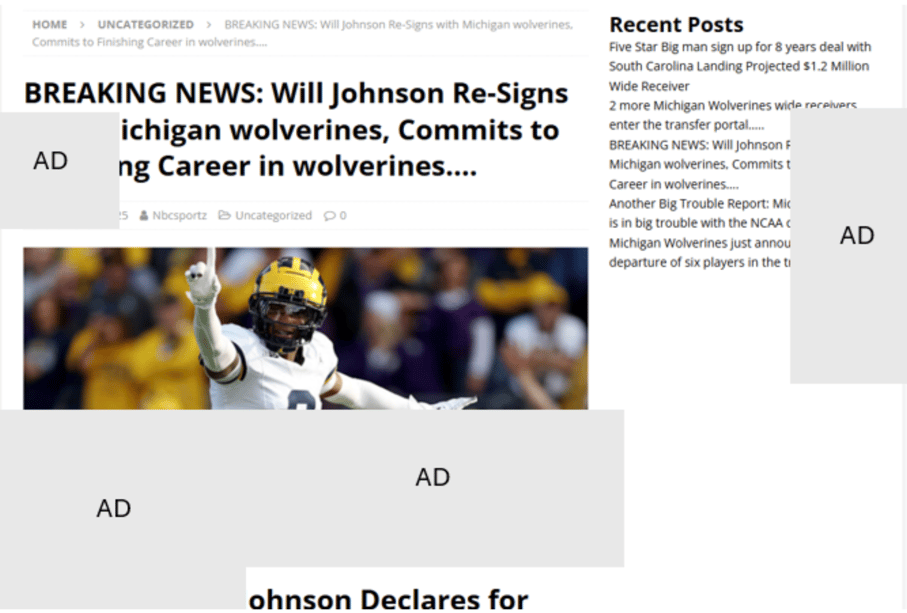
Notably, dozens of sites within the network use terms like “sports” or “sport” in their URLs, capitalizing on the perception of sports content as “safer” or “more suitable” than traditional breaking news. However, as this network demonstrates, simply being sports-focused does not inherently justify ad spend. It also underscores the need for more discerning evaluation and a reconsideration of the value of news, which is undervalued.
Unsurprisingly, the user experience on these sites is poor, which negatively impacts campaign performance for any human visitors. AI-generated slop sites worsen the issue by overcrowding their pages with ads, creating a frustrating and cluttered reading experience. This highlights the need for tools that help brands avoid unsuitable or harmful placements, based both on content and overall presentation.
The Solution: GenAI Low-Quality Avoidance and Real-Time Protection
Some advertisers attempt to address this issue by relying on exclusion lists to block known low-quality sites. However, thanks to GenAI, these lists struggle to keep pace with the rapid creation of new domains. For example, DV recently reviewed a popular blocklist from a leading demand-side platform (DSP) and found no reference to over 90 percent of the GenAI sites that DV tracks today, including no blocking of the sites featured in this report. This is why relying on static lists to combat a dynamic and evolving threat landscape is challenging. Unlike other solutions that require manual list updates, DV’s avoidance solution is kept up-to-date dynamically and automatically.
To address the growing challenge of low-quality GenAI content, DV developed tools to identify and avoid AI-generated slop sites before they impact advertiser budgets. Our GenAI Avoidance technology leverages advanced machine learning to detect patterns indicative of AI-generated content, including repetitive cookie-cutter formats, chatbot-generated text within articles, placeholder content and other markers, allowing advertisers to preemptively exclude these sites from their campaigns.
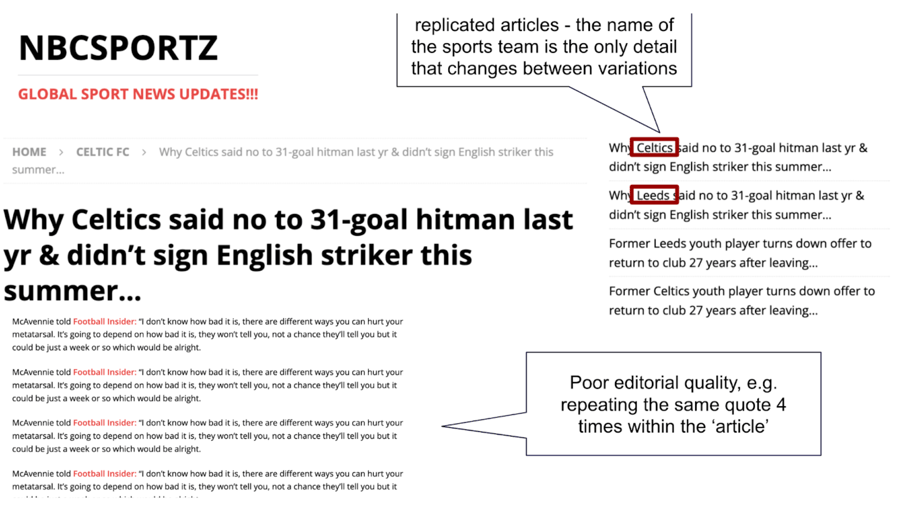
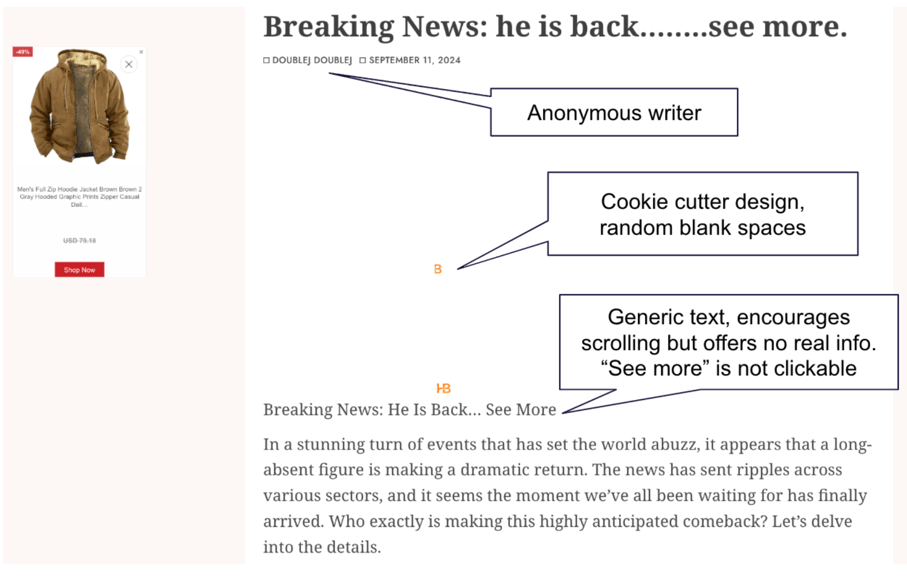
With DV’s GenAI solution, clients can seamlessly enable post-bid monitoring within their brand suitability profile and employ DV Authentic Brand Suitability® across leading DSPs for pre-bid avoidance. This tool not only helps advertisers avoid wasting money on low-quality inventory but also ensures that their brands are represented in trusted, authentic environments.
It’s important to note that, like any cybersecurity mechanism, pre-bid tools are not 100 percent infallible, as they are constantly updated to respond to an evolving threat landscape and rely on appropriate user settings and preferences. However, without these tools, billions of advertising dollars are wasted every year.
Evolution Is a Necessity
The Synthetic Echo network is a clear reminder to us all that fraudsters are always innovating. By mimicking legitimate publishers and exploiting perceived safe zones like sports content, bad actors are finding new ways to deceive advertisers. As the industry becomes more reliant on automation and AI, it’s crucial to implement multi-layered verification processes to protect ad spend and maintain consumer trust.
DV remains committed to staying ahead of these threats, providing advertisers with the tools they need to navigate an increasingly complex ecosystem. With solutions like GenAI Avoidance, we’re empowering brands to safeguard their campaigns and ensure that every impression counts.
If you’re not yet a DV customer, now is the time to act. Reach out today to learn how DV’s GenAI Avoidance can help protect your ad spend and elevate your campaign performance. For current DV clients, contact your account manager to ensure you’re fully leveraging our GenAI tools to safeguard your brand and optimize your strategy.
This piece is part of DV’s Transparency Center, a dedicated portal designed to educate the industry about DV technology and measurement. By providing detailed explanations, insights and timely statements on key issues, we aim to foster trust and transparency within the digital advertising ecosystem.





